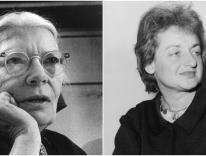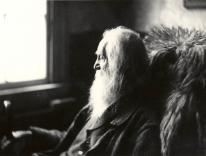I spent six months in Mexico back in 1929, most of the time in Mexico City and Xochimilco. The churches had just been reopened and there was only one priest in all the capital who heard confessions in English. His understanding of the language was so bad he shouted to make you understand him, and the other penitents kept tactfully the church-length away during the long afternoon's wait to be heard. The political situation was bad, but when isn't it? It was a time of fiesta days, and every time the fireworks exploded we thought another revolution was starting.
Diego Rivera was among the many Mexicans I met then. He was large and genial and had just come back from Russia, where, he told me, I had rubles waiting for me for the many translations into all the languages of the U.S.S.R. of my article "Having a Baby," which had originally appeared in The Masses. It was a happy article and I was glad to hear that it had been translated. The baby, then going on four years old, was with me there. She had been baptized four months after birth and I had been baptized eighteen months later.
I remember Rivera well, and I remember that I had been up against enough anti-Catholic and anti-religious propaganda among some of the artists and writers of The Masses not to be shocked at his attitude toward religion. I probably even agreed with much of Rivera's criticism, especially in regard to the wealth of the Church and the luxury of the clergy. But my Catholicism was an act of faith. "Though He may slay me, yet will I trust in Him." It had seemed like death, at the time, to become a Catholic.
The serious articles which I wrote while in Mexico, about the political situation, were all rejected by the Catholic magazines to which I submitted them. So I remembered the journalistic training I had received under Lionel Moise, the famed city editor who also taught journalism to Ernest Hemingway, and I began writing features about Tamar and myself. It was the beginning of Tamar's life in print and she has had to be content to be a part of my writing ever since. (Once when there was a long gap in my mention of her in articles a reader wrote to ask if she were dead!) I wrote about our visit to Our Lady of Guadalupe's shrine, about Easter in Xochimilco, about living with a Mexican family, about Adolpho Fuentes of the revolutionary party who took us on picnics in his truck on Sundays, about living with the people (Communists would call them the peasants) who farmed the manmade islands of Xochimilco.
I was there six months at that time and only returned to New York because Tamar became ill. And now I have spent another two weeks on a pilgrimage there. I presume to write about Mexico on the basis of just this much experience, but then Evelyn Waugh wrote an entire book about Mexico after only a two months' visit. He did not apologize, saying that it is the function of the journalist to "hope to notice things which the better experienced accept as commonplace and to convey to a distant public some idea of the aspect and feel of a place."
THE TWO ARTICLES I wrote in the Catholic Worker about this pilgrimage called forth some sharp rebukes from critics of the Church who blame all the poverty and illiteracy of Mexico on the clergy. Who is their scapegoat for the poverty I have seen in America, that of the sharecroppers and the tenant farmers, the migrant workers, the Negroes and Puerto Ricans in our city slums? And why has not the revolution done more for the poor in Mexico in the hundred years since the reform laws were passed? But I do not want to enter into controversy. I will get on with my impressions, because that is all this article will be.
"But did you enjoy yourself?" Fritz Eichenberg asked me, after he had read my two articles in the Catholic Worker, and since they were apparently not personal enough for him, I shall make this very personal.
Yes, it was a happy trip. I enjoyed Father Neudecker's talk on the train between Kansas City and San Antonio and Laredo (and that part of the trip was most comfortable). I enjoyed the cartons of good whole wheat bread which he had baked himself at Kellogg, Minnesota, where he "earns his living" by grinding wheat and selling good flour as St. Paul earned his by sailmaking. I enjoyed his sitting up with us all night on the trip from the border to San Luis Potosi (accent on the last syllable), when it was freezing cold and the doors of the car would not stay closed. The old missionary with us took a berth, thank God, and the other priest, who should have, caught a very bad cold, but maybe it was Father Neudecker's whole wheat bread which saved him. The toilets overflowed, the car became filthy, but still it was not as bad as the front cars, which were of wood, with wooden seats and open windows.
Yes, I enjoyed that cold night—it was part of a pilgrimage. I enjoyed it as St. Francis did the ashes on his bread. Coming into San Luis Potosi four hours late, we received Communion at one of the three Masses offered, and then had our first solid meal at a little hotel. (Of course we had had plenty of Father Neudecker's bread.) Then our three guides drove us in their three cars over the most beautiful mountains and plains to Guanajuante, a town so entrancing that I should choose to stay there rather than at Taxco or Cuernavaca or any other tourist place. We put up for two nights at the Sante Fe hotel on the plaza. At night a band played and the boys and girls walked around and around, the boys going in one direction and the girls in another so that they were constantly repassing one another. When the band stopped, other musicians with stringed instruments and very solemn faces played Mexican music and sang mournfully.
THE NEXT MORNING after an early Mass we set out for the Mountain of Christ the King, on the top of which is a great shrine, a tremendous statue like that of our Statue of Liberty, which was erected on this highest mountain of central Mexico to replace one which had been bombed by a lone Communist aviator back in 1928 or before. Perpetual adoration is offered at a shrine of the Benedictine nuns of Christ the King in a convent a little way down the mountain, which is seven thousand feet high. You can imagine the view of the world around us in that crystal clear air, high, high above the surrounding hills and plains.
One of the things about this old civilization is that no matter how far you go in the wilderness there are always signs of human habitation. There are no fences, but there are always shepherds and herdsmen, on foot, living with their animals, father and son, sitting with neighbor father and son. Oxen do the ploughing, harvesting is by hand, threshing is as it was in Biblical times. The land is old, and the ways of the people are ancient, too. They are lean and spare and pruned to the bone.
The next day we started promptly at nine o'clock in the morning and drove in our three cars to San Miguel d'Allende named not only for St. Michael but also for d'Allende, a national hero who (as one of the guides told us) pushed Father Hidalgo into revolution when he hesitated. We had an elaborate lunch there, in a hotel which was formerly a Franciscan monastery and is now the most luxurious building the town offers for travelers' accommodations, and visited the art school, which is also a former monastery. It is not only that the Orders were robbed of their possessions and of the fruit of their hard work; there is evidence too of a decline in vocations and the ability to build such foundations again.
We drove another hundred miles to Tolucca, and then on for forty-five miles to Mexico City. The city was a dazzling sight, a sea of jewels, as we came down the mountains into the old lake bed where the city is situated. Our hotel was spacious, with hot baths and high ceilings, but it was on a mean, narrow street. There was no restaurant in the hotel nor any near at hand, and the other pilgrims wanted to move, which we did the next day, although it was Sunday.
It is strange about pilgrimages. The high point should have been that Sunday morning, when we went out to the shrine of Our Lady of Guadalupe, three miles away from the center of the city. Street cars and buses, cabs, taxis, every kind of conveyance was directed toward that little hill of Tepayac, where the Blessed Mother, in the guise of a young Indian maiden of fifteen, appeared to Juan Diego (the Spanish name for the Indian) and told him that she would be the protectress of the Indians, that she loved them. Everyone knows the story, how she filled his tilma, a sort of burlap blanket he wore over his shoulders, with Castilian roses, which did not grow in that part of the country or at that time of year at all. He brought his roses to the Bishop, who, with those around him, at once fell on his knees in veneration. For there on the tilma was painted a miraculous picture of the Indian Aztec Virgin, Our Lady of Guadalupe. This all happened in 1531, and the best telling of it, from the original documents, is to be found in The Dark Virgin by Donald Demarest.
But the moment of exaltation does not come according to a timetable. We were on pilgrimage, and we had guides who had scheduled our tour—one day we were to be here, another there. Very often, of course, we did slip away from each other and kneel in those magnificent churches and basilicas among the people of Mexico City and among the poor, barefoot, white-clad, silent and devout, who kneel for hours, their arms outstretched, their eyes on the face of the Virgin or our Crucified Lord. It was all so different from everything we knew, that we had been accustomed to. We were distracted constantly by the crowds, and by the individuals who absorbed our attention. And there was the climate, the rarefied air at that tremendous altitude, twelve thousand feet.
A PILGRIMAGE LIKE this is the time to be carried along with the others, to keep a diary, or to write letters home that will be saved for you to refresh your memory with. Later on, it is often a sudden smell of charcoal or beeswax, or the feel of cold stone under your knees, or the sight of another at worship that recalls you.
I visited the shrine again before we left, but I am always terribly distracted by people. No matter how long I stay, no matter how resolutely I try to close my eyes, ears and thought, my worship remains an act of will, a gesture of the body. I am present, but I am not carried away. Certainly I am more of ten overtaken by joy and thanksgiving in my own parish church at home. No matter how much of a pilgrim I consider myself, and call myself, I am wedded to home, to the House of Hospitality, to the parish where we live in New York. It is my vocation.
On our last day we had an audience with Archbishop Miranda, and he kept us for two hours, talking to us about the Church in Mexico. We felt blessed indeed. The laws against the Church are still on the books, as they are in France, he pointed out. It is not only in Russia that the Church is being persecuted. The great need, he said, is for vocations, and for lay apostles to help the priests. This great archbishop is also a believer in non-violent resistance to oppression. During the worst of the persecution there was not a bishop in Mexico who advocated armed resistance. Always the emphasis was on the spiritual weapons, on prayer and suffering. There were many martyrs.
Sunday, after Mass, I left on the noon bus, the Chuihuahua line, for El Paso, the ticket costing eleven dollars and fifty cents. The other pilgrims were returning by train or plane. The roads were good, the seats conducive to relaxed comfort, we were warm though there was a severe cold spell through central Mexico, and I was overjoyed to hear one of my fellow passengers reading aloud, from a copy of the Catholic Worker which I had given her. She was reading some of Peter Maurin's Easy Essays to the only other English-speaking passenger in the crowded bus. Not at all distracted by the hub-hub around her, she read and laughed aloud, and constantly said, "But this is remarkable!"
Peter Maurin, Catholic Worker founder, had reached a few more people, and I was on my way home, back to work with the new strength one always gains from a pilgrimage.
[For more of Dorothy Day's writings from Commonweal, see our full collection.]
Please email comments to [email protected] and join the conversation on our Facebook page.
Share
Previous Story
Religion and Public Life
Next Story
The Other America


